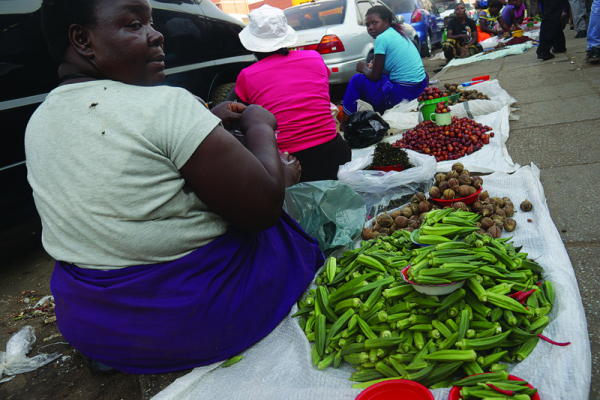
Despite the cat and mouse games between illegal and “legal” traders or vendors by law enforcement authorities in recent days, from the hustle on door-steps in down-town business shops and the bustle on central business district (CBD) pavements, to the revered designated market sites and now deserted and rejected stalls at Rotten Row and Simon Mazorodze Road in the capital, people’s lives have always revolved around market places; vending to be precise.
By TONDERAYI MATONHO
With the newly built, reconstructed and now deserted market places, it means that the fit is not yet right. With such facilities, will vendors be able to purchase and stock their stuff adequately, keep them healthy and make use of various services, including a management facility, provided by a professional association, to help with customs and local traditional formalities?
Most critical of all, are the new sites accessible and near enough to the consumer and favourable to the vendor? Vendors themselves have always pointed this out and the local authorities have not given an ear to this important observation.
At this juncture, when unemployment rates are abnormal, vendors are being evicted with impunity from the city centre by law enforcement agents, time and space should be created to engage and find each other to create harmony and provide the best facilities to operate from.
By setting up these critical points of convergence, the main idea is to promote fair trading, maximise the interface between vendors and the city fathers.
Any form of a market place and their performance, depends a lot on their facilities and their proximity to the consumer. Despite strengthening their efforts through local authorities over the past decades, most developing countries’ open market facilities, have been inadequate or non-existent, particularly in sub-Saharan Africa.
If the city council was listening enough, they should come up with a set of objectives in such an imbalanced equation with input from the vendors themselves through their associations:
- Chamisa under fire over US$120K donation
- Mavhunga puts DeMbare into Chibuku quarterfinals
- Pension funds bet on Cabora Bassa oilfields
- Councils defy govt fire tender directive
Keep Reading
l Eliminate the nuisance of shambolic vending, which had become an eyesore in the capital and other cities and towns, where no adequate markets were built since independence;
l Create and build a trading area with attractive and adequate facilities which will help to generate business and jobs; getting a grip on and increasing its tax revenues;
l Providing an accessible market place for consumers and good working conditions for vendors; and
l Help create vendors’ productivity;
Experts have said a good market place should be futuristic and its forms making it an architectural curiosity for quite some time.
Vendors should not fight to get stands or stalls in the market and these should be parcelled out fairly and apolitically.
In such situations, visitors and consumers normally balk and prefer to buy their goods and look for services elsewhere. Illegal vendors set up shop, as it were, in front of retail outlets, grabbing customers passing by or as soon as they step out of their cars.
The cost of maintaining and cleaning in a market, noted experts, should not be expensive for vendors when the work is carried out by council services. The costs should be shared out on the basis of the space occupied by each vendor or trader. In the current case, this is good because vendors have banded together and formed associations representing their interests and rights.
Through these associations, they take care of the maintenance and daily cleaning tasks and manage the market, in consultation with consumers. The city council, which used to perform these tasks, will now provide technical support. The result: savings in costs, better allocation of stands and better security.
Arguably, the question will be, exactly which vendors or traders will be enticed to such markets and not the free-for-all that had established itself with uncontrolled transfers of rights, sub-letting, buyouts and bribes? Only those who can afford to pay taxes, the costs of maintenance, entrance fee and investment, rent or buy a stand or lock-up, should operate such markets.
This scenario will meet the demands of both customers and traders for notable improvements in hygiene and security.
Furthermore, with the passage of time, this will create small and medium traders, who were already located in the formal part of the old market place. This will be a virtuous circle.
The other vendors from the old market, too “poor” to buy into the new one, will melt away and join the throngs of informal and rejected vendors and in the process work hard enough to go up the ladder of market affluence.
Social and economic experts say that the numbers of rejected vendors should not be allowed to grow. Although it has always been a thorn in the flesh in city fathers’ sides there is always a way to deal with informal trading.
Thousands of individual vendors are all vying for space in the Harare, Bulawayo, Gweru, Mutare, Kadoma, Gwanda, Bindura, Kariba, Hwange and many other smaller town markets. Attractive fruit and vegetable selling malls, shopping centres for second-hand clothes will have to be constructed.
Directors of markets and fairs in the city councils will need to confirm that it is possible to include thousands of informal vendors in the new markets because the resources and facilities are available. Partnerships to build such market places and more will be formed and co-financed with international development agencies and council working groups will assess the impact of such projects.
With such attractive formations, more and more vendors will hope for a place in the market place. All the vendors who had to leave to make way for the construction works will have to be rehoused and more space will still be there for more.
Rather than chase each other all day long, through ruthless evictions, as the saying goes, why make a song and dance about it, when the solution is so obvious.
lTonderayi Matonho writes in his personal capacity











